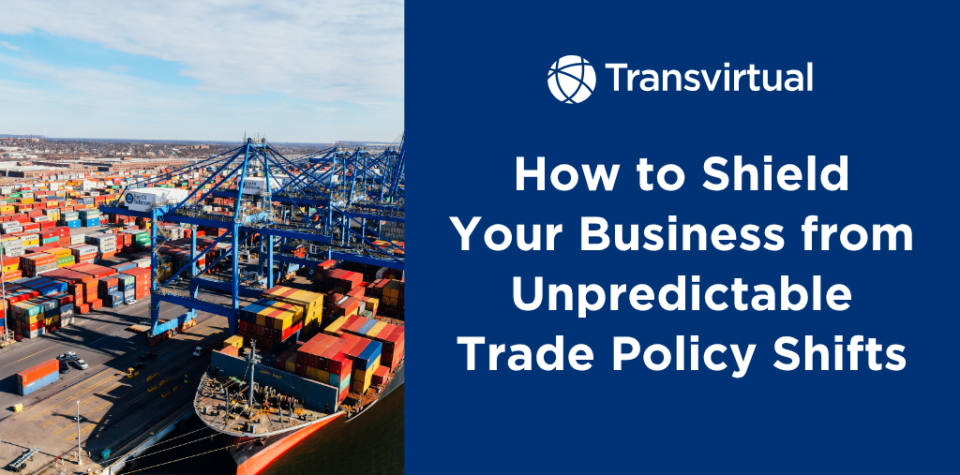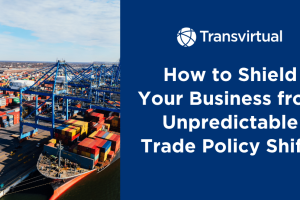Table of Contents
The 90-day tariff truce between the United States and China rocked the logistics industry. Importers rushed to get containers across the Pacific before duties were set to spike again. You probably felt the ripple — tighter chassis pools, longer drayage queues, and sudden rate swings. When policy pivots with little warning, you need a plan, not luck, to keep freight moving and margins intact.
Reality Check in Numbers
Policy turbulence bites harder every quarter. Global trade expanded by roughly $300 billion in the first half of 2025, while shipments only increased by about 1%. The imbalance shows on your docks. Container imports through the Port of LA surged 8% year-over-year in June to a record 892,340 TEUs as importers rushed to beat the tariff clock, stretching drayage and chassis capacity to the limit.
Confidence on Main Street faltered simultaneously. The National Federation of Independent Business optimism index has drifted downward since December 2024, and planned capital outlays sank to their lowest point since 2020 last April. Credit offers little relief. The average small business loan amounts to $443,097, which is much more than many operators desire or can secure when cash flow is already limited. This is especially true for small business owners who may be seeking poor credit loans.
With cash reserves limited and policy unpredictable, fleet teams look inward for savings. Utilizing electric trucks and warehouse equipment leads to higher cost savings as the cost of electricity to charge equipment is less than the cost of fuel. Together, these signals shout one lesson: freight markets move faster than policymakers, and resilience costs money.
7 Actions That Keep Freight Moving
Changing trade rules can jack up landed costs, choke import lanes, and twist delivery timetables. You can still stay ahead with these deliberate moves.
1. Diversify Ports and Transload Corridors
Shift volume among West Coast, Gulf, and East Coast gateways, or even Canadian and Mexican ports, to sidestep bottlenecks. When LA piles up, routing a share through another location gives you breathing room and rate leverage. Maintain multiple customs brokers so clearances continue even if one trade zone stalls.
2. Lock Flexible Carrier Contracts
Structure service agreements with sliding bunker formulas and optional vessel strings. You keep guaranteed space yet reserve the right to adjust origins or destinations with minimal penalties. That flexibility preserved margins during the recent surge, when spot trans-Pacific rates briefly ran above contract levels.
3. Double-Down on Inventory Visibility
Deploy cloud control towers and container-level Internet of Things tags. Real-time estimated time-of-arrival data lets you resequence production or redirect stock before detention charges accumulate. Shippers that track in-yard dwell during spikes can slice average chassis turn time, while non-tracked loads may languish.
4. Leverage Nearshoring and Friend-Shoring
Even shifts in partial bills-of-materials can trim tariff exposure. In April 2025, French auto-parts maker Valeo shifted plastic mold tooling out of China and into treaty-friendly plants in Mexico and the United States. The move brought 90% of its Mexican exports into full USMCA compliance, shielding almost all U.S.-bound parts from new tariffs and stabilizing landed costs.
5. Build a Tariff Emergency Fund
Set aside at least one month of duty exposure in liquid reserves. Rising global trade value hides higher price tags, and margin erosion can sneak up. With capital spending plans already soft, access to credit could tighten further, so rely on internal liquidity first.
6. Automate Yard and Warehouse Gear
Battery-electric forklifts eliminate oil filters, spark plugs, and engine rebuild schedules, keeping techs available for high-value repairs and ensuring uptime when surge volumes hit. Pair them with autonomous mobile robots to maintain throughput when overtime budgets tighten.
7. Model Landed-Cost Scenarios Weekly
Load current tariff, freight, and currency data into your enterprise resource planning every week so quotes stay solid while rumors swirl. FreightWaves shows most new truckload contracts already stretch beyond three months and annual bids are returning, while Xeneta finds 12-month deals still lead at 43% and three- to six-month pacts climbed to 26%.
Next Steps to Fortify Your Finances, Facilities, and Fleet
Trade rules can shift faster than your next billing cycle. Ensure you financing, facilities, and fleet are ready to absorb the shock with these strategies.
Financing That Flexes
Keep working capital nimble. A rolling, regularly updated 13-week cash flow forecast identifies weak spots when projected duty payments threaten to soak up available credit. If a gap appears, consider supply-chain finance programs as a smarter alternative to term loans and secured loans. This market reached $5.7 billion in 2023 and grows 8.7% a year, so revolving capacity expands even while banks are cautious. Round out liquidity by hedging foreign exchange and bunker costs to match tariff review cycles.
Facilities That Breathe
Treat floor space like cash. Because much of a picker’s shift is pure walking, better slotting reduces travel time and labor costs. Put fast movers by the dock and shove slow movers up high. When storage still overflows, exploit today’s softer real-estate market — U.S. industrial vacancy rose to 6.3% in the first quarter of 2025, giving tenants leverage for short leases and early-exit clauses. Plug the remaining gaps with portable fabric structures that install in days and roll off the balance sheet as variable expense, so capacity breathes with demand instead of calcifying in concrete.
Fleet and Yard Intelligence
Telematics plus idle-shutdown coaching nudged the average fleet fuel economy from 7.62 mpg in 2022 to 7.77 mpg in 2023. Inside the gate, dock appointment software cut truck turnaround by about 30% at Walmart distribution centers in 2022, freeing chassis and trimming detention. Use the fuel savings to fund recurring driver-training refreshers and small telematics upgrades that keep good habits sharp. Track appointment metrics on a shared dashboard so dock leads can spot dwell creep early and tweak schedules before detention costs resurface.
Stay Nimble, Stay Ahead
Trade policy will swing again — maybe next quarter, maybe next year. You can’t control diplomats, but you can control preparation. Diversify nodes, automate labor-hungry tasks, keep liquidity ready, and frequently revisit cost scenarios. Proper planners thrive. Freight professionals who treat volatility as normal earn trust from customers and keep freight flowing while rivals scramble. Turn policy noise into opportunity by being agile, funding wisely, and sharpening your logistics ecosystem now — not in response to the next big change.

